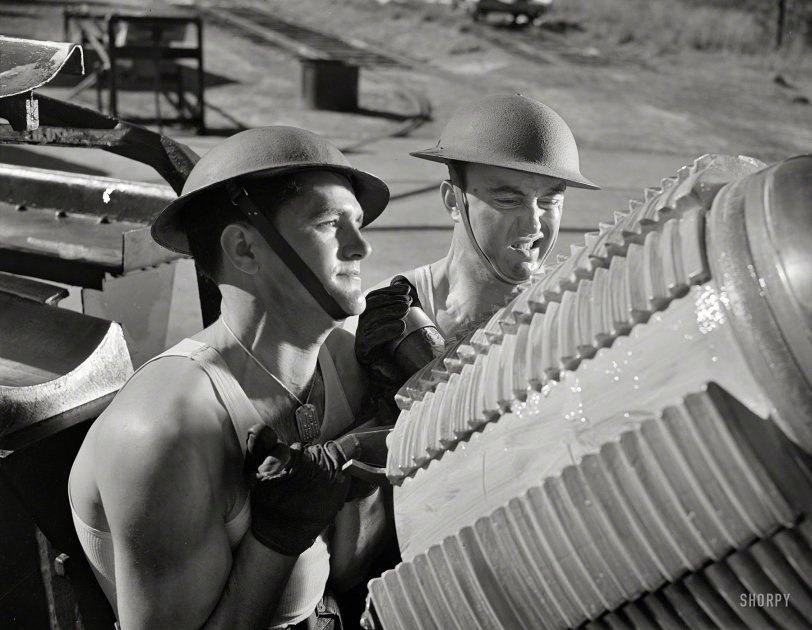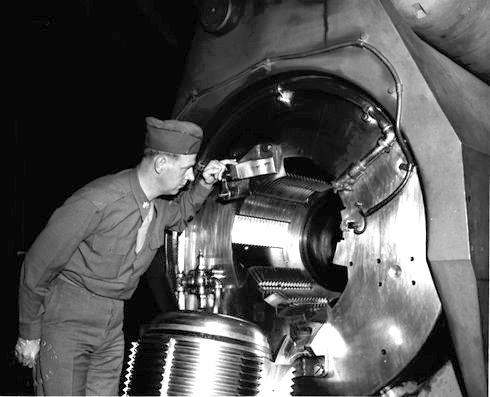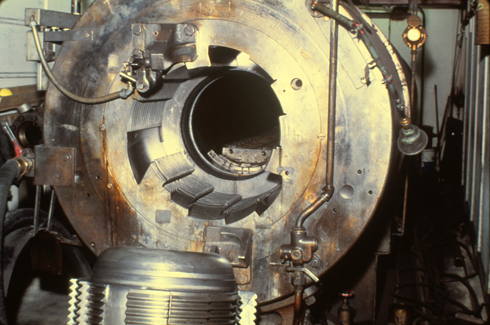


Framed or unframed, desk size to sofa size, printed by us in Arizona and Alabama since 2007. Explore now.
Shorpy is funded by you. Patreon contributors get an ad-free experience.
Learn more.

- Illuminate us
- I remember it well
- I can't prove it
- Complicated then, forgotten now
- Bryan-Stevenson
- Skinny is as skinny does
- How do you rest in peace
- Riding the footboards
- Alas, hidden from view
- Baldwin Diesels
- Exclusive pump
- Bananas, Oysters and Smokey Joe
- Details, Details
- What's that building to the left of the tower?
- Coal Barges
- Bromo-Seltzer
- Inner harbor
- The Basin
- What a headache!
- Giant stepladder?
- Yeah, it was cold
- Love those coats
- Link & Pin Days Remnant
- Baldwin 62303
- Baldwin VO-1000
- Cold
- No expense spared
- Tough Guys
- What's your hurry, where's your hat?
- Sheriff's Signature
Print Emporium
Shove It: 1942

March 1942. Virginia Beach, Va. "Fort Story coast defense. A tough job for soldiers is shoving the breech block of the giant howitzer into place. The screw threads help the block to withstand millions of foot-pounds of pressure caused by the exploding charge." Photo by Alfred Palmer, Office of War Information. View full size.
Breach
This type of breach lock is known as buttress thread.
Finally a picture from here…
I live at the beach, just blocks from Fort Story. It is a very small base and my friends and i would hang out there and skateboard down these hilly road that they built on the sand dunes. That was in the early 80's, but it is still the same now. We would sneak through the woods and "smoke" back there and find old bomb shells just laying the sand. 4ft long at least. They have a bunch of underground bunkers with doors that appear to go into a sand hill… Very odd looking with rusted old locks on the doors. There was a strip club on the base that we could also sneak into and drink at 16. I was never in the service, nor were my friends, but we certainly had a great time on that base. No one was ever around…? We never met a single military person. Still i have only met a few, and lived in Va. Beach for 44 years. Good Times. Thanks Shorpy.
Coastal Artillery
Many Coastal Artillery regiments were converted to anti-aircraft units around this time. The 200th Coastal Artillery Regiment was a New Mexico National Guard anti-aircraft coastal artillery regiment, converted from a cavalry regiment in 1940. They were sent to the Philippines, arriving in November of 1941. A great number of them died in Japanese captivity
M1917A1 Helmet
Lectrogeek, the helmets worn in the photo are the Model 1917A1--the shell is the standard Model 1917 of World War I vintage, but with an improved liner and chin strap assembly. The modification was authorized in 1936 and the modified helmets began to be produced in 1940.
The M1 helmet ["steel pot"] was adopted in the summer of 1941, but due to a delay in tooling up to produce the new helmet, the M1917A1's continued to be made through the end of 1941 and were widely used throughout 1942 until the supply of M1 helmets caught up with the demand. The older helmet was declared obsolete later that year and the M1 helmet would go on to serve through the mid 1980s.
From a different angle
These soldiers are man-handling the breechblock of a 16-inch caliber howitzer, a massive weapon that fired a shell weighing over a ton.
Here's a view of a similar breechblock on a 16-inch gun in the defenses of San Francisco that illustrates the scale of these artillery pieces. (The highly burnished steel shows the care that soldiers lavished on these huge -- and expensive -- weapons.)

Into the Breech!
Here's what the view in the other direction looks like.
Some of these 16" guns (this is a Navy model) were used for industrial purposes for super-high pressure powdered metal sintering.
This particular one is still in use today!

All dressed up and nowhere to go
Except for the defense of Corregidor in 1942, a few engagements during the Civil War, and some salient actions during the War of 1812, the US Army's seacoast artillery never fired a shot in anger. Nevertheless, that arm was responsible for many innovations, particularly in fire direction techniques and gun design, that paid significant dividends when applied by the field artillery in both world wars, Korea, Vietnam, and the Gulf.
As for the WW I-style helmets, they were retained in low-priority units (such as Stateside coast artillery batteries) well after we entered WW II because priority for the new "steel pot" helmet naturally went to units deployed or deploying into harm's way. Army and Marine units that left the States after Pearl Harbor did so with the new helmet, of course, but those troops fighting in the Philippines from December 1941 to April 1942 had to be content with the Doughboy's "tin hat," designed primarily to protect against overhead artillery bursts and virtually useless against anything else.
Where?
Is it just me, or does it have the look of being shoot in a studio or on a sound stage?
[It resembles that look because Palmer aimed supplementary flash from the right to illuminate their faces, which otherwise would have been in shadow. -tterrace]
Keep Strapped, Boys!
Many a soldier's neck was broken from exploding ordnance within their proximity during WWI, thanks to the chin strap. No wonder many doughboys refused to strap themselves in.
Doughboy helmets
Rather than the pots that soldiers cooked in from WW2 until the advent of Kevlar in the late '80s, these guys appear to be wearing leftovers from the previous war.
Being a pedantic engineer.
The term would be "pounds per square inch" of pressure. "Foot-pounds" is a unit of torque, not pressure.
[Foot-pound can also be a unit of energy. - Dave]
























On Shorpy:
Today’s Top 5